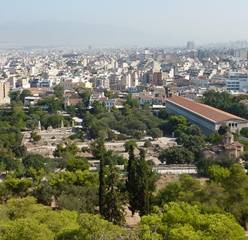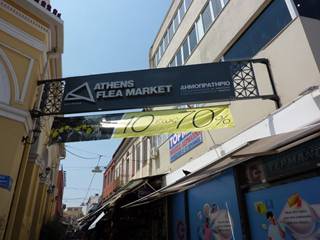Athens trip: Akropoli

|
Thursday 12th August – Athens trip: Akropoli 37:58.120N 23:43.774E
It may be our wedding anniversary today but there was no time to dwell on it – we were up at 7am for the start of the hotel breakfast and then off to the Acropolis to start our site seeing before the heat of the day and before the many tourist coaches that would be arriving. We were armed with our 'Greek Island Hopping' guide as it has really good maps and descriptions of the sites.
The Acropolis We were there just after it opened at 8am and spent a good 1½ hours wandering round this famous and impressive site – there is still plenty to see, despite Greece's assertion that Elgin nicked everything (though I think we will be taking a trip to the British museum on our return to UK to finish our tour J).
To be honest I was a bit disappointed with the amount of building works, workshops, and use of new materials to renovate the buildings (it was difficult to get a photo without a crane in it!), though I can appreciate that they are trying to reverse damage done by previous renovation projects and I read that they are trying to limit of the impact of the new materials.
The interior of the Parthenon was bombed to bits by the Venetians in their battle with the Turks, and so will be constructed of entirely new material when they have finished. As we walked round, the site became busier and the temperature soared; as we emerged there were numerous coach parties wending their way up the approaches.
Athens: The Acropolis
Athens: Odeon of Herodes Atticus
Theatre of Dionysis We came back down the hill to the Theatre of Dionysis, where most of the plays of Greek tragedy and comedy were first performed, and from there back to the hotel for half an hour to cool off and re-freeze.
Athens: Theatre of Dionysos
Ancient Agora Our next site was the Ancient Agora (market place) which was a large site of genuine ruins of buildings and incorporating the Temple of Hephaistos, a very well preserved temple, and a small but nice museum built at one side of the site. It also has the ruins of a prison that it has been speculated may have been the incarceration and execution place of Socrates.
Athens: Ancient Agora
Kerameikos From here we went to Kerameikos, the ancient cemetery. We saw the ruins of the cemetery from above as we walked along the street down towards the entrance and so didn't feel we needed to walk round it but spent the time in the museum. I enjoyed this museum most of all, maybe because of the macabre subject matter, but also I was impressed by the photos of the statues with how they had been found and rescued. The various monuments to the dead had been plundered and used to build roads; the ones on display in the museum had been unearthed and the photographs showed them 'in situ' at the Sacred Gate.
Athens: Kerameikos
Athens Flea Market On the way back through Monastiraki we walked through the Athens Flea Market with various shops selling old and new.
Athens: Monastiraki & Athens Flea Market
Library of Hadrian Next we visited the Library of Hadrian. It was built by the Roman Emperor Hadrian in 132-134 BC as a donation to the city of Athens. The entrance has an impressive column facade. The eastern side had a two storey building and it is still possible to see the remains of the storage niches that were used to store the papyrus scrolls. There is a small exhibition room on the site which houses the large Nike statue that was discovered on the site.
Athens: Hadrian’s Library
Roman Agora Our final stop was the Roman Agora, much smaller than the Ancient Agora. It is a fairly sparse area with a few columns remaining, some ancient Roman latrines and the octagonal Tower of the Winds (Horologion of Andronikos Cyrrhestes). The latter is an impressive tower that was a water-clock, sundial and weather vane combined. On the top used to be the now lost Triton Weathervane. Around the top of the tower is a series of carved figures each depicting a wind of the compass; apparently you could also tell the time of day by where the sun fell below the figures (a sort of tower version of a sundial). There was also a waterclock which was used on cloudy days and at night.
Athens: Roman Agora
Totally 'templed out' we staggered back through the Plaka district to the hotel for a rest.
Athens: Around Plaka
In the evening we headed out for something to eat. Having failed to find the next Lonely Planet Guide recommendation but managing to explore the backstreets of an Athens suburb, we settled on a small but charming family run cafe near Makrigianni . The food was good and inexpensive (apart from the ‘greens’ that I forgot to ask the price of before ordering, and, unfortunately, even I found inedible).
© Pyxis 2010
|

























































